50 years after NASA’s renowned Apollo moonshots, the 98-meter rocket will attempt to launch an empty crew capsule into a far lunar orbit.
To the Moon Again
NASA hopes to put two people on the lunar surface by the end of 2025, but if everything goes according to plan, astronauts could strap in as early as 2024 for a trip around the moon. The launch from NASA’s Kennedy Space Center is scheduled for Monday. NASA officials caution that the six-week test mission is dangerous and might be shortened if something goes wrong.
‘We’ll put it under pressure and test it. To attempt to make it as safe as possible, we’re going to make it do things that we would never do with a crew aboard,’ NASA Administrator Bill Nelson told The Associated Press on Wednesday.
There is a lot riding on this trial run, according to the retiring founder of the space policy department at George Washington University. ‘If things go wrong, spiraling expenses and lengthy intervals between missions will make for a difficult comeback.’ According to John Logsdon, ‘it is intended to be the initial stage in a sustained program of human exploration of the moon, Mars, and beyond. Will the United States have the determination to move forward in the event of a significant failure?’
More than $4 billion were spent on just this one mission. The tally is even more shocking if one totals up the costs from the programme’s commencement ten years ago through a lunar landing in 2025: $93 billion.
The Power
Compared to the Saturn V rockets that launched 24 Apollo astronauts to the moon 50 years ago, the new rocket is shorter and leaner. But with 4 million kilograms of thrust, it is more powerful. The Space Launch System rocket has so far been referred to as SLS, although Nelson claims that a less awkward moniker is being considered. The new rocket, in contrast to the Saturn V’s sleek design, includes two strap-on boosters that were modified from NASA’s space shuttles. The boosters will not be recovered from the Atlantic for reuse, but will peel away after two minutes just like the shuttle boosters did. The core stage will continue to fire before detaching and fragmenting when it crashes into the Pacific. A higher stage will launch the Orion spacecraft toward the moon two hours following liftoff.
In order to tax the systems, Orion’s flight is intended to last six weeks from its Florida launch until its Pacific splashdown. The 386,000 km journey to the moon will take about a week. Following a quick circle of the moon, the spacecraft will reach a far-off orbit, putting Orion 450,000 kilometers from Earth—further than Apollo. As Orion enters the atmosphere at 40,000 kph on its approach to a splashdown in the Pacific, the big test occurs towards the conclusion of the mission. The heat shield, which can endure reentry temperatures of 2,750 degrees Celsius, is made of the same material as the Apollo capsules. However, the sophisticated design accounts for future Mars colonists’ speedier and hotter returns.
Apollo continues to be regarded as NASA’s finest accomplishment more than 50 years later. Armstrong and Aldrin landed on the moon just eight years after Alan Shepard, the agency’s first astronaut, was launched into space. From 1969 through 1972, twelve Apollo astronauts made a total of twelve trips to the moon, each lasting no more than three days. A varied pool of 42 astronauts will be used for Artemis, and NASA is expanding the period that crews will spend on the moon to at least a week. The objective is to establish a sustained lunar presence that will smooth the way for manned missions to Mars. Once Orion is back on Earth, NASA’s Nelson vows to reveal the first Artemis moon crews.
What Does the Future Hold?
Before humans return to the moon, there is still a lot of work to be done. Possibly as early as 2024, a second test flight will transport four humans around the moon and back. NASA plans to launch four more around a year later, with two of them landing in the lunar south pole. Like the Apollo spacecraft, Orion lacks a built-in lunar lander, so NASA has contracted with Elon Musk‘s SpaceX to supply its Starship spaceship for the first Artemis moon landing. Moonwalking suits are being developed by two further private businesses.
A pair of astronauts would be transported to the moon’s surface by the futuristic-looking Starship before returning to the capsule for the return trip to Earth. Before trying a crewless moon landing, Musk plans to launch Starship around Earth on SpaceX’s Super Heavy Booster. Starship has one drawback: before travelling to the moon, it will need to refuel at a fuel station in Earth orbit.








